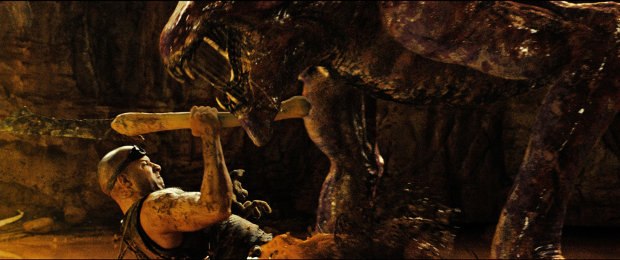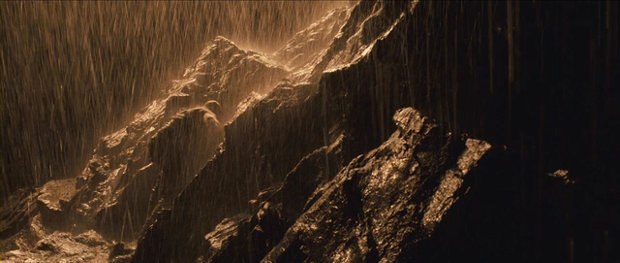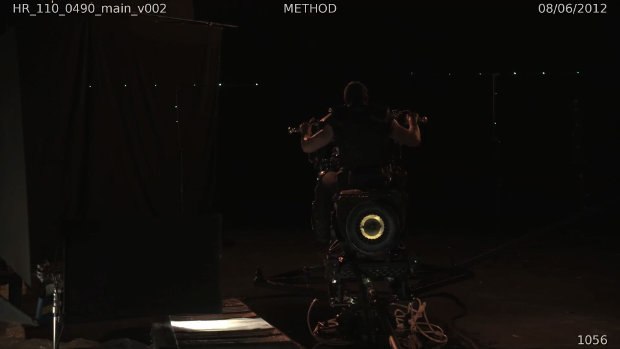Nordin Rahhali discusses the challenge of animating creatures for the latest Pitch Black sequel directed by David Twohy and starring Vin Diesel.
Watch two separate VFX progressions from Riddick by Method Studios on AWNtv!
Riddick is a welcome return to its Pitch Black origins. Vin Diesel's eponymous badass is left for dead on a scorched planet, pursued by bounty hunters and alien creatures called mud demons. For Method Studios, the creature work was a new challenge after specializing in environments for years. It entailed a new pipeline and greater animation finesse.
Riddick also marked one of the first times that the LA facility collaborated closely with its London and Vancouver sister studios on the 100 shots, spread among 110 artists. Nordin Rahhali supervised the work out of the LA office while Ollie Rankin did the same in Vancouver. Since then they've collaborated together on White House Down. Gunnar Hansen served as the production VFX supervisor
The mud demons lie dormant in caves until the infrequent rain season begins and then migrate in the hundreds to kill. They come in several sizes, bare razor sharp teeth, move on two legs and have scorpion-like tails with pinchers. In some scenes they had more than 120 creatures visible, all with random shader attributes so they didn't look like clones and contained different walk cycles. Then they animated multiple hero creatures to enhance key moments.
In addition, there were the usual VFX elements: full CG environments, environment extension, CG digi-doubles, CG rain/mist/mud, lightning and electricity gun effects. Method used Maya, Houdini, Zbrush, Mari and Shotgun, and rendered in V-ray and Mantra and composited in Nuke.
"The mud demons are bi-pedal and have a third joint in their leg and they're arms are very nimble," explains Rahhali. "It was an interesting case study of motion because the creatures were defined by three categories: the teenager, the momma and the bull or what we called big daddy. He was the male adult, very large, much more muscular and much more amour-plated. The vast majority were teens and we gave them texture and shader variations that would differentiate them from females, which were one color scheme. The young males also had red stripping on their bodies. That was procedurally done for the bulk of the creatures. Momma and daddy were used for the two fight sequences we worked on."
But they had to revamp their creature pipeline. They had a mechanism in place for multiple characters but not for the amount of characters required for Riddick. They could no longer rely on brute force.
"So we changed the way the rigs were generated on the front end. We switched fully to alembic to speed things along. When the animators published, the system would turn out a light rig as well as an accompanying alembic cache [smaller geometry file format]. It's getting improved all the time with some attributes that don't carry through. You have to use a light rig but the majority of what we had in our scene was alembic. It's very lightweight and fast and allowed the lighters to handle lots of creatures without being slowed down."
The biggest challenge, as Rahhali suggests, was movement. The original design was fully upright and it looked goofy. They wanted it to be lower to the ground and it hadn't been done at any other studio where it needed to run or crawl very much. "They wanted scary so we went through several stages and presented David with tests. The animators had a lot of fun getting them to a near crawl. Its arms were extended outwards and looked bizarre. The tail was so long that instead of looping it like a scorpion, we put it back on the ground and used it almost as a third leg. We did another test where it was hunched over and used the tail more like a scorpion and that was successful. In the end, we used all of those, which was bizarre because David didn't just want one way of moving. He liked the low crawling, creepy move; and he liked the more upright moves on a few occasions because, again, they have to be nimble when going over rock."
The most ambitious sequence was called "Demon's Peak." After outwitting and then banding together with his adversaries to survive the mud demons, Riddick gets impaled by one of the pinchers and closes the wound with hot, molten rock, and then proceeds to make his way up a peak, which is all matte painting. However, while climbing the peak, he gets pursued by hundreds of mud demons.
"This whole sequence takes place on a small set with a rain bar," Rahhali continues. "We had to extend it and add water and lightning and other atmospherics and all the creatures he's interacting with. We were driven by Riddick's performance and made it as chaotic and life-threatening as possible. We came on to it late and weren't able to go to the shoot so we were limited by the data that we had. But we made the most of it and were able to get everything sitting in there the right way.
"He keeps making his way toward the peak and the creatures get bigger and badder. One of the mommas attacks him. He throws his weapon and kills her; then he's attacked by one of the dads as he gets to the top. We had to replace everything to make it look like he was holding the corners of the creature's mouth. We used a lot of the rain in the plate, put a mud demon in there and replaced hands. There were several intense over-the-shoulder shots as well from Riddick and the creature along with the creature striking with its tail. The crew comes to his rescue in a space ship and blast the creature in half with a hell fire gun. David left it open for us to develop the look of the blast and I suggested these hot cores going from green to orange that look like copper sulfate and he liked that. There was also lots of goo and blood thrown in as well."
Method also worked on the previous sequences involving the bounty hunters pursuing Riddick on bikes that look like hovering Harleys with turbo thrusts below that interact with the ground.
"That whole environment as they're riding toward Demon's Peak was all-digital. Gunner had done a lot of set photography at Bryce National Park. They liked those alien-looking sculptures that happen in nature as something they could replicate on this planet. They also wanted an ambient light to illuminate the background with lightning flashes.
"There were a lot of Hoodoo rock formations. They wanted to crunch it and have it look claustrophobic and dark. They couldn't do a normal back plate and work with a LUT. The problem was they were going so extreme with the look that they'd have a hard time balancing all the layers of the rain and the effects. So we ended up coming up with those looks in-house by baking them in.
"Everything was so sepia that I thought if they were going to go with this bronze look, to me the lightning was a perfect opportunity to split tone this environment with cyan. We worked with the compositors to give the lightning frames a graphic quality. We drove part of the DI process with David and Gunner at our studio here. That doesn't happen very often."
--
Bill Desowitz is former senior editor of AWN and VFXWorld and the owner of Immersed in Movies (www.billdesowitz.com). He's also a columnist for Thompson on Hollywood at Indiewire and contributing editor of Animation Scoop at Indiewire. Desowitz is additionally the author of James Bond Unmasked (www.jamesbondunmasked.com), which chronicles the 50-year evolution of 007 on screen, featuring interviews with all six actors.





















